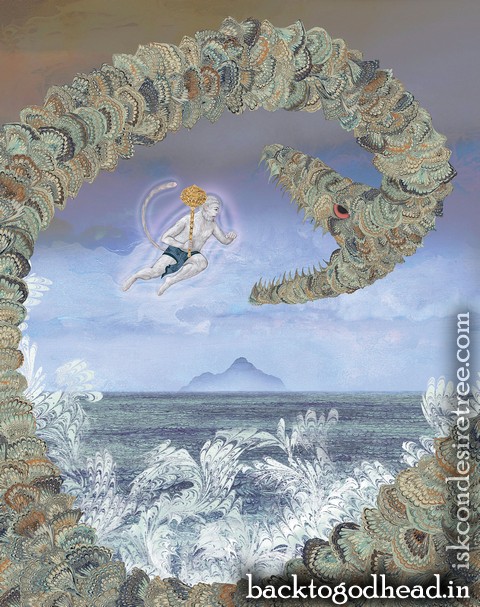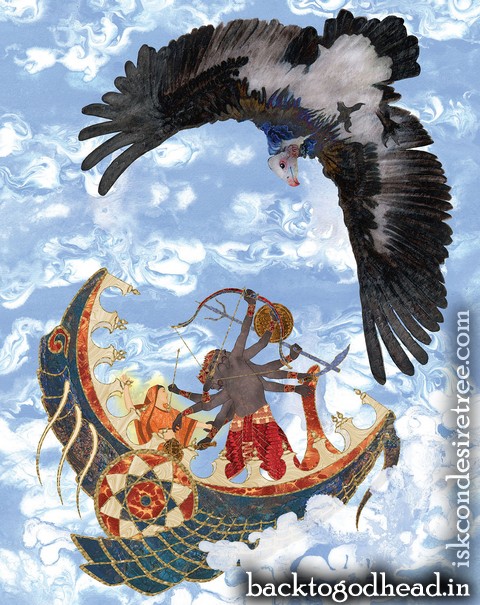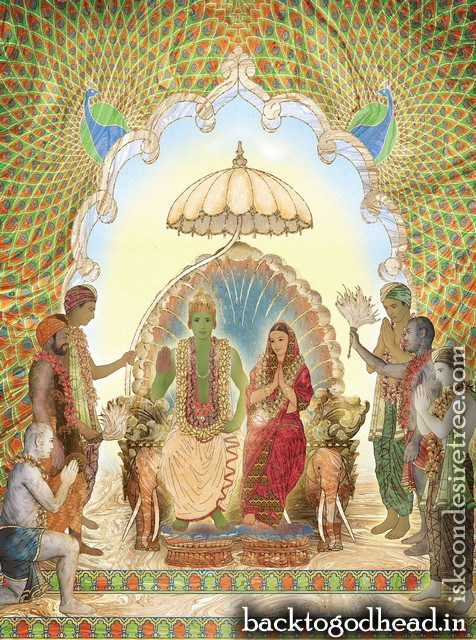Fifty new paintings illustrate Valmiki’s immortal tale of Lord Ramachandra’s divine activities on this planet.
The new, abridged, edition of the Ramayana produced by the Mediterranean division of the Bhaktivedanta Book Trust features the art of Italian artist Parama Dasa, whose mastery of state-of-the-art computer software is evident in his extraordinary illustrations. The text of this edition of the Valmiki Ramayana was compiled by Purnaprajna Dasa and is based on the Gita Press edition. Here we present an excerpt from the book, along with samples of the art. The excerpt starts after the epic final battle, as Lord Ramachandra and His associates are about to leave Lanka for Ayodhya
Vibhisana swiftly brought the Puspaka chariot, the astounding vehicle that Ravana stole from Kuvera. It was built by Visvakarma mostly from gold. Its seats were made of vaidurya-manis, gems that display different colors. The mental indications of its driver were enough to direct it anywhere.
Thus the fine chariot awaited Rama and Lakshmana’s commands, and They felt astonished.
Before departing, Rama requested Vibhisana to give gold and jewels to all the monkey soldiers.
Mounting the Puspaka chariot with Laksmana and Sita, Rama addressed all those around Him: “There is no way I can repay you monkey warriors for your heroic fighting on My behalf. Your unflinching devotional service will always serve as an inspiration to future devotees. Your glories will shine forever. Now please return to Kiskindha and live happily under Sugriva, your king.
“Dear Vibhisana, immediately begin governing Lanka, for the citizens are bereft of their king.”
Standing before Rama with joined palms, Sugriva and Vibhisana pleaded, “O Lord, please allow us to accompany You to Ayodhya we shall return home after seeing Your coronation.”
Rama replied, “There is nothing that would please Me more than returning to Ayodhya with all My dear friends. Please mount the Puspaka chariot, and let all the other monkeys and Raksasa heroes also enter.”
After everyone was comfortably seated, the Puspaka chariot majestically lifted off.
The monkeys, bears, and Raksasas were enjoying the flight, while Rama pointed out all the sights to Sita.
Rama said, “See the great battlefield where all the heroic Raksasas died for Your sake. Over there is Nalasetu, the bridge we built to cross the ocean. There, on the far shore, is Setubandha, where the construction of the bridge began. From now on, Setubandha will be a sacred place, capable of washing away all one’s sinful reactions.”
When Rama pointed to Kiskindha, Sita said, “I would be pleased if I could return to Ayodhya with all the monkey chiefs’ wives.”
Rama granted Sita’s wish, and after halting the chariot, He instructed Sugriva and others to go and invite their wives. Once everyone was seated, the journey continued.
Rama said, “Look, there is Mount rsyamuka, where I met Sugriva, and nearby you can see heavenly Pampa Lake, which is full of blue lotuses. Further on, You can see the river Godavari, and, on its shore, Agastya rishi’s asrama.
“Dear Sita, see there, the spot where Ravana kidnapped you. And there is Citrakuta, where Bharata met Me. There is the river Yamuna, and there the mighty Ganga; see there, Srngaverapura, King Guha’s capital.”
In this way, Sita, Rama, and Laksmana remembered Their entire forest life in reverse order as They retraced their way back to Ayodhya. Finally, They saw the river Sarayu, and, at last, the outskirts of Ayodhya. Before entering Ayodhya, Rama ordered Hanuman, “Go and inform Guha of My arrival; I will spend the night at Bharadvaja rsi’s asrama. And then go to Nandigrama to describe to Bharata everything related to Sita’s abduction and rescue. Carefully watch Bharata’s expression when He hears about My arrival and then report back to Me. If Bharata wants to rule the kingdom for position, power, royal luxuries, or even because Kaikeyi urges Him to I will be glad to grant it to Him.”
Hanuman took a human form and departed through the air. He did what Rama had ordered him and first went to Guha. Arriving at Nandigrama, Hanuman saw Bharata with matted hair, dressed in tree bark. Bharata had been living in a cottage. He ate only fruit and roots, and He appeared to be miserable and emaciated.
Hanuman approached Bharata and said, “I have come here as Rama’s messenger. He inquires about Your welfare and announces His swift return to Ayodhya.”
Hearing these nectarean words, Bharata’s face lit up with delight. Exhilarated by deep emotions, he suddenly fainted. Coming to his senses, Bharata stood and embraced Hanuman with great joy and bathed him with tears.
Bharata said, “Because you brought me this good news, I will immediately reward you with a hundred thousand cows, a hundred villages, and sixteen girls of marriageable age. Please sit down and tell me everything that happened during Rama’s exile.”
Hanuman narrated everything and revealed his identity.
Hearing about Rama’s imminent return, Bharata exclaimed, “My cherished desire will finally be fulfilled.”
Bharata ordered Satrughna to prepare everything for Rama’s reception. Sumantra and other ministers soon arrived at Nandigrama on elephants, and Kausalya, Sumitra, and Kaikeyi came on palanquins. Engineers and work crews quickly constructed a new road to connect Nandigrama and Ayodhya.
After all these arrangements, Bharata took up Rama’s sandals and a white royal umbrella. Accompanied by brahmanas, He left His cottage, while conches were blown and drums beaten.
The news spread, and almost the whole of Ayodhya, eagerly expecting Rama, had come to Nandigrama.
After some time, when there were no signs of Rama’s arrival, Bharata warned Hanuman, “This better not be a frivolous joke, monkey.”
But Hanuman pointed to distant dust clouds the monkeys were approaching, and their roars could now be heard.
Finally spotting the Puspaka chariot, Hanuman happily shouted, “Sri Rama comes.”
A clamor arose as the crowd saw the Puspaka chariot appear. Out of respect, everyone dismounted his horse, elephant, or chariot, and from a distance, Bharata already started worshiping Rama. With joined palms, He recited prayers and then offered articles. Finally, when Bharata saw Rama magnificently aglow in the front seat, He bowed with the greatest reverence.
The celestial chariot landed, and Bharata climbed aboard to greet His elder brother. Rama immediately rose to embrace Bharata with affection. Next, Bharata warmly greeted Laksmana and Sita.
Meeting and embracing Sugriva, Bharata said, “Now you are like Our fifth brother.”
In the meantime, Rama approached Kausalya and lovingly clasped her feet. One after another, Rama greeted Sumitra, Kaikeyi, and Vasistha. Then all the citizens welcomed Rama.
Placing Rama’s wooden shoes on Rama’s lotus feet, Bharata said, “The kingdom I have been governing in Your absence is flourishing by Your mercy, and the treasury, storehouses, and army have increased tenfold. My duty is now fulfilled, and thus I relinquish everything to You.”
Rama ordered the Puspaka chariot to return to Kuvera, its original owner. The vehicle ascended and headed north.
Bharata requested Rama to accept the throne without delay and resume a life of royal luxury. Rama consented, and barbers were summoned to shave His matted hair. Rama bathed and dressed, and the three mothers dressed Sita and the monkeys’ wives marvelously. At Satrughna’s command, Sumantra presented a lavish chariot to Rama, and Rama graciously mounted it. On the chariot, Bharata held the reins and Satrughna the royal white umbrella, and on either side of Rama, waving fan and camara, stood Laksmana and Vibhisana. From the sky, demigods and sages glorified Him with carefully chosen words.
Rama proceeded toward Ayodhya followed by an enormous procession. When Rama entered His capital, all the citizens lined the streets and welcomed Him. Men, women, and children all gazed upon Rama as if they had regained their lives.
About the Artist: Parama Dasa was born in Gallarate, northern Italy, in 1976. His family joined the Hare Krishnacommunity near Florence in 1982, and he began his education in the gurukula school there at age seven.
Parama received his diploma from the State Art Institute in Flor-ence in 1996, specializing in theatrical scenography. During his studies he began copying art of the Renaissance, and after graduation he worked in a restoration laboratory, where he learned classical pictorial techniques.
For ten years, beginning in 1998, he reproduced more than 150 commissioned works of the most important European artists of the period between the 1400s and the 1800s. He has also developed his own aesthetic language, combining classical and modern techniques with the latest digital technology.



